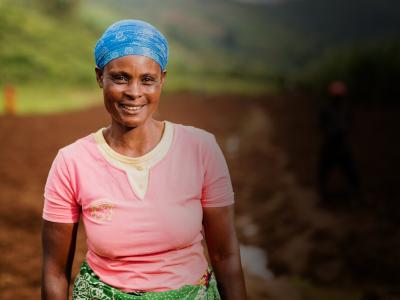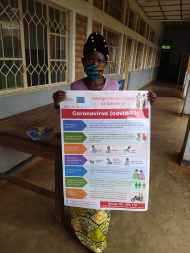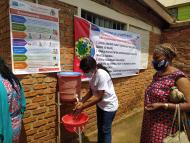As one Ebola outbreak was declared done, another sprouted in its place. The Democratic Republic of the Congo continues to wrestle with this hydra while simultaneously dealing with the COVID-19 pandemic.
Though the diseases differ in many ways, both pose great risks to women and communities we serve. The same issues of infrastructure, distrust, access to health care and resources, conflict, and gender inequality put women at risk and at the front lines of disease.
Audry Shematsi, our Country Director in DRC, has experience working in communities threatened by Ebola and brings that expertise to Women for Women International’s programs. We spoke with her about what it’s like working at the intersection of multiple infectious diseases.
What's it been like dealing with coronavirus in DRC? How have things changed?
Contagious diseases that go from an infected person to a healthy person like COVID 19 are not new in the DRC.
We must understand that we have several epidemics that are ravaging our populations. In addition to Ebola, we have cholera and measles, which have been in the country since 2018. On top of that, we have malaria.
In some publications, there is talk of more than 30,000 cases of cholera for the year 2019 alone, with 23 of the 26 provinces affected. Concerning measles, there have been two outbreaks in 2 provinces of the South East in the same year.
And all of this must take into account the issues of sexual violence that women face every day of their lives.
The tendency is to want to focus all our resources and efforts on COVID 19. My request would be that we also take into account other diseases and other socio-economic problems.
Which disease poses a greater risk to the communities we serve?
Ebola. We've had several outbreaks in the DRC. We are more or less experienced in prevention and response, and many researchers say that Ebola disease is more dangerous because it has a mortality rate of about 60%, even with treatment.
Personally, I had a privilege to work in Ebola-affected communities in my previous role. I got vaccinated as did many humanitarians. I feel more protected from Ebola than COVID.
The common element in both diseases is that they are both fear-inducing.
What is a big challenge in getting rid of Ebola?
Getting rid of Ebola means getting rid of all the fruit bats in our forests that are the natural Ebola disease host. And how? By destroying all our forests? Do you think it's possible? I don't think so.
Ebola is an unpleasant neighbor. We have to know how to live with it. One important way is to strongly observe health measures.
We also need to consider: What impact does all this have on women and girls?
What’s is the current situation for communities living with multiple outbreaks?
For the time being, COVID-19 called a pandemic and an epidemic until proven otherwise.
In the South Kivu province where I am based now, we had five cases of Ebola last year, and it was reported in Kasika community in Mwenga Territory. Women for Women International is running programs on women’s empowerment in Kasika. We have not had any cases so far.
For the moment, the provinces that are worried about Ebola are North Kivu and Equateur (Mbandaka). North Kivu is closer to our province than the Equateur (Mbandaka).
Ebola has so far affected only four provinces since 2018. COVID-19 is in 10 provinces out of the 26 currently in DRC.
I understand that for those who are far from the DRC, it is frightening to know that we have the Ebola epidemic and the COVID 19 pandemic at the same time.
What do you think needs to happen next?
First, these are some examples of what we are doing now:
We have trained our staff on COVID-19 and Ebola. We ensure that the hygienic measures or barriers are observed. At the community level, we have readjusted our training approach by reducing the number of women in a class to 20, and keep a distance of 1.3 meters between them. And we have set up hand washing stations in all our training center and provided masks to our participants
Next, at the individual level, for COVID 19, we have to accept that it exists in our communities. Acceptance will be shown by observing the prevention measures.
For Ebola, it's the same thing, too, with the addition of avoiding eating the bushmeat.
But at the organizational level and as we work, we must adapt all interventions in such ways as to not expose staff and the communities we serve to the virus.
we should be aware of the need of the community generated by the virus: soap, clean water, masks. We need to raise more funds to get more resources.
We need a community-based approach matter to minimize backlash and distrust while establishing clear communication with communities.
We should combine our efforts with other actors to ensure that the disease is neutralized by either working on prevention and response.
We’re fortunate to have a dedicated team in the DRC who support women through disease and on their journey to find their power. With their expertise, our team has been able to safely resume trainings for women who need these resources, skills, and knowledge even more as they navigate poverty, conflict, and gender discrimination on top of outbreaks.
Learn more about how we are supporting women through the COVID-19 crisis


